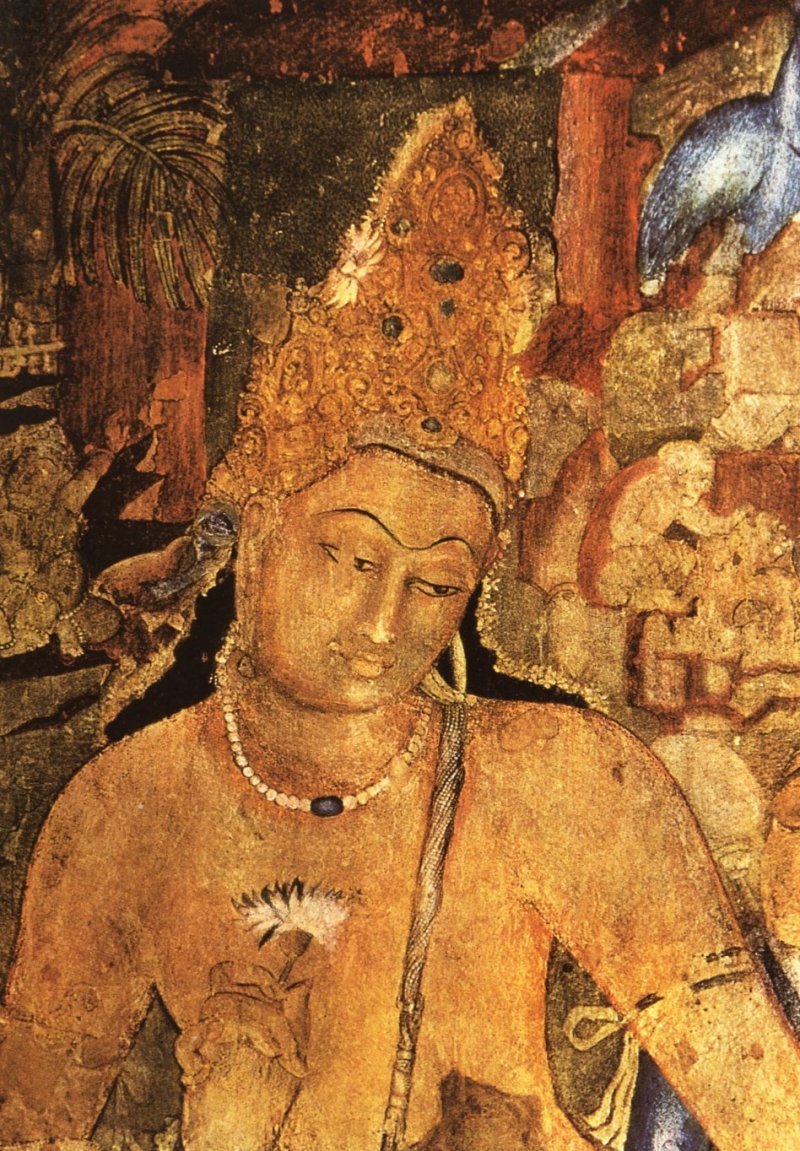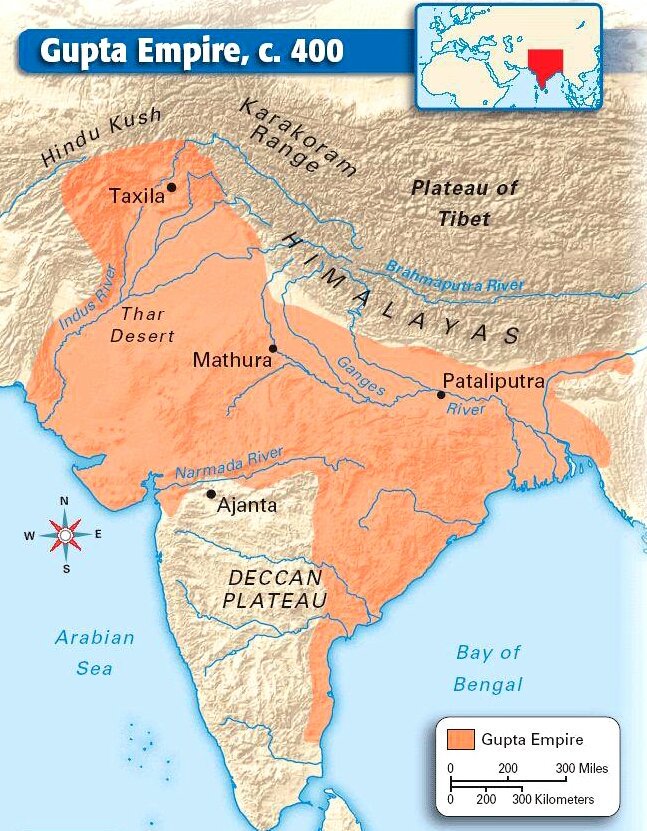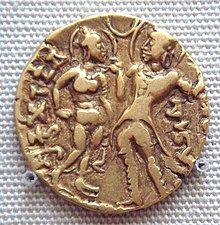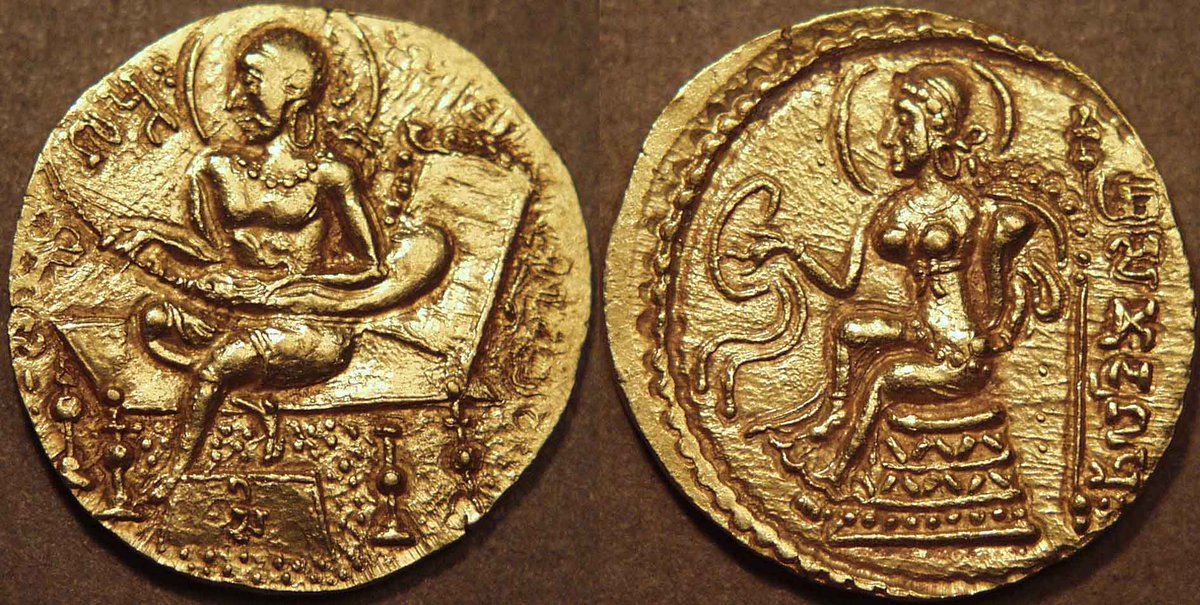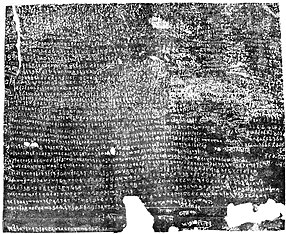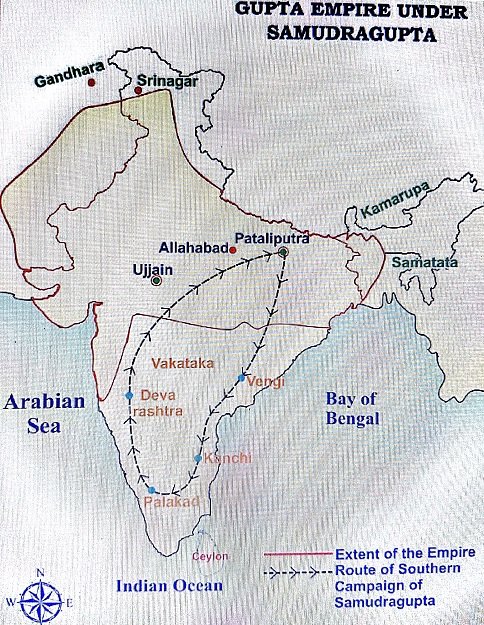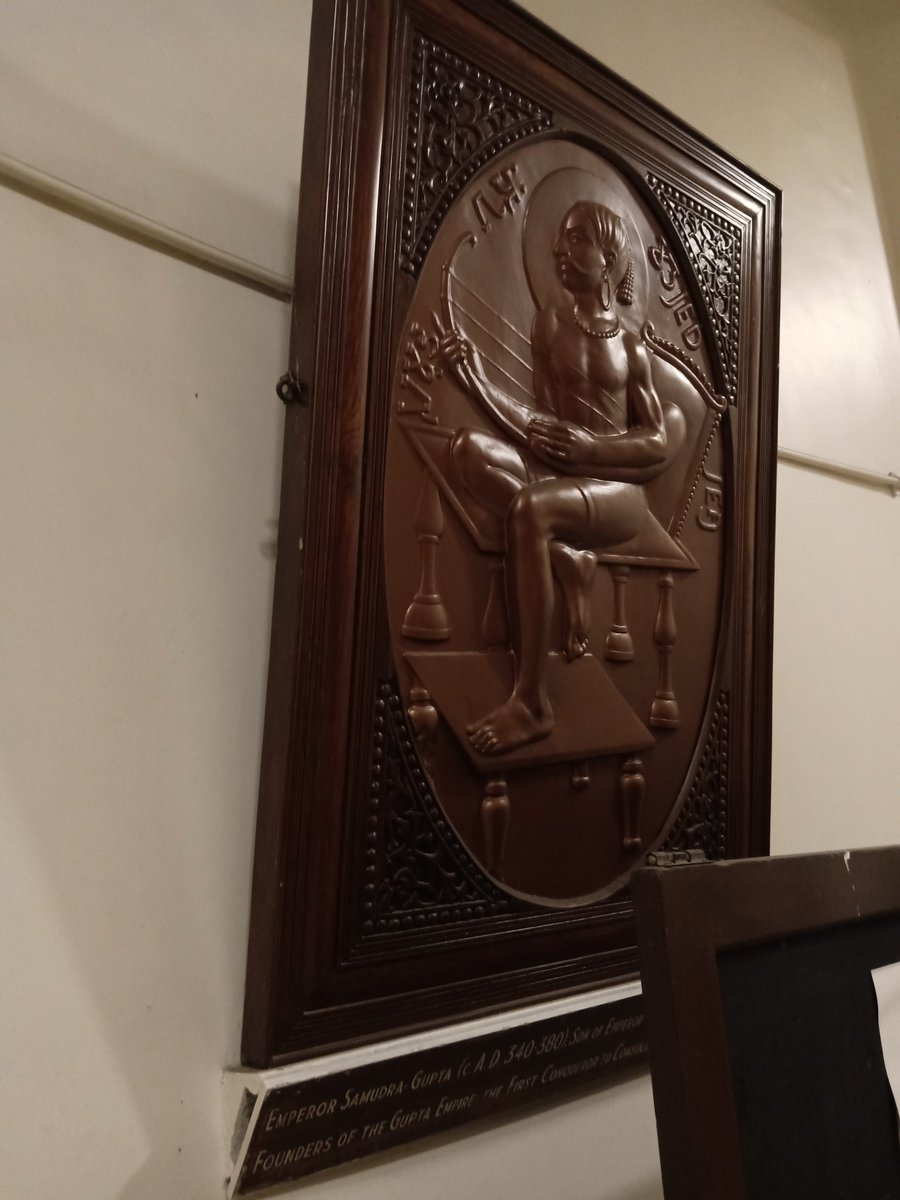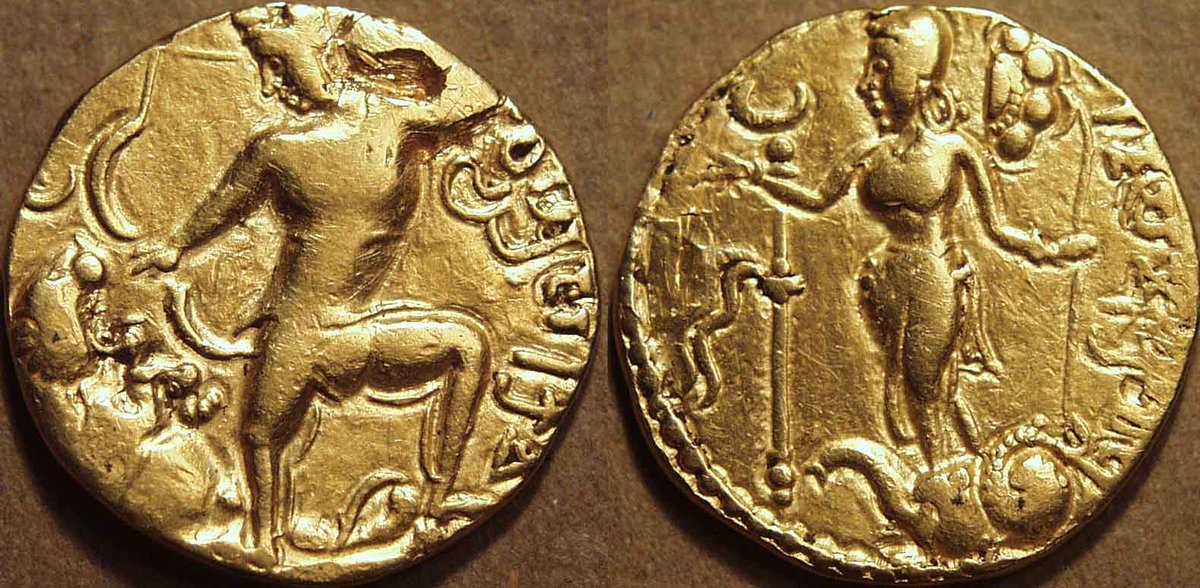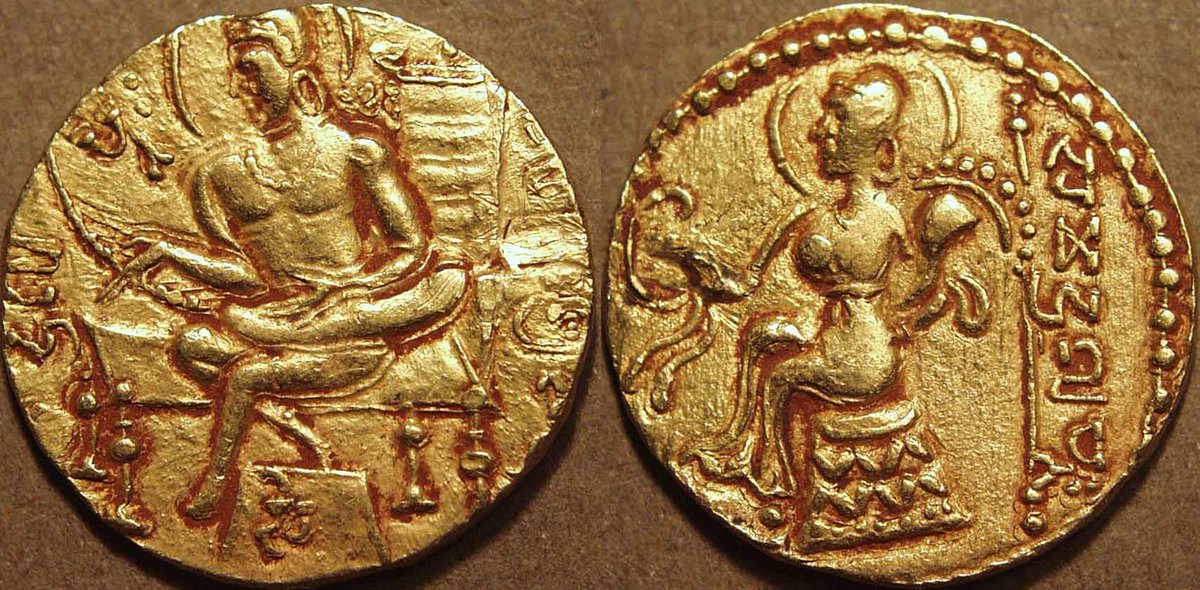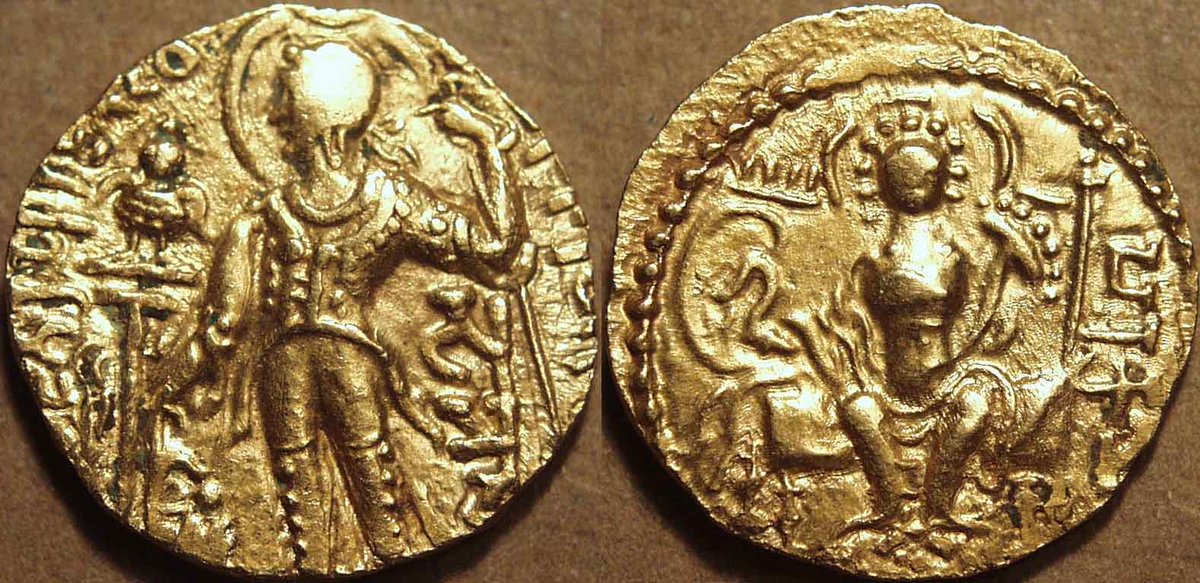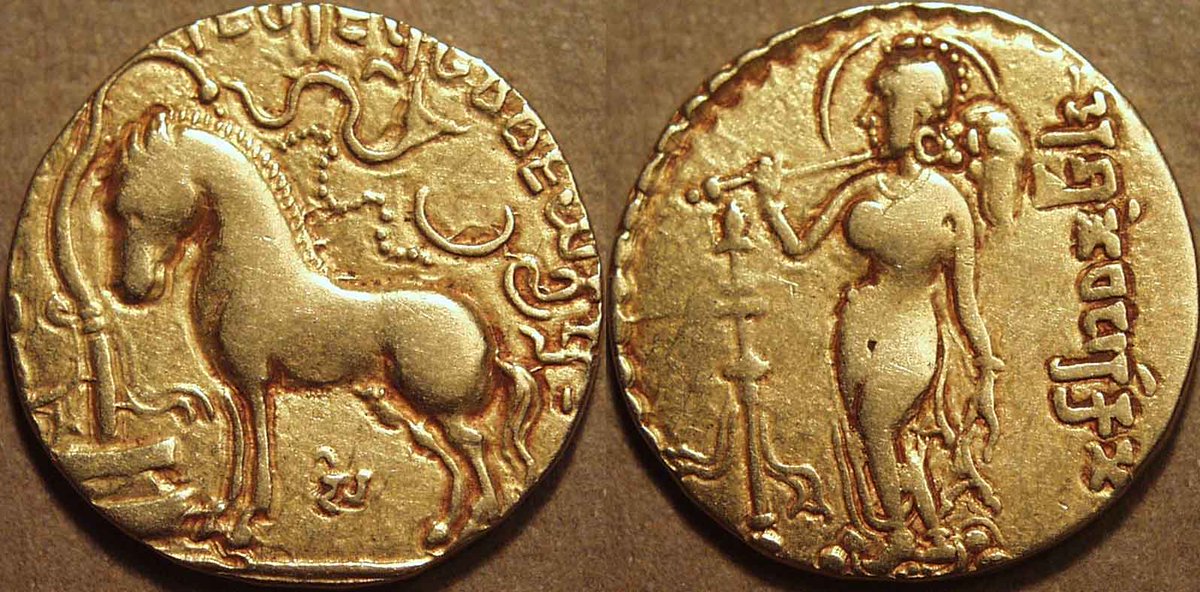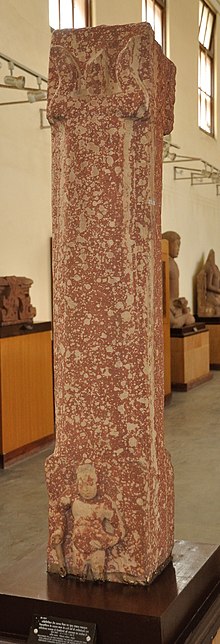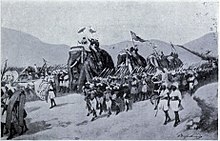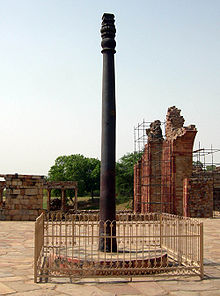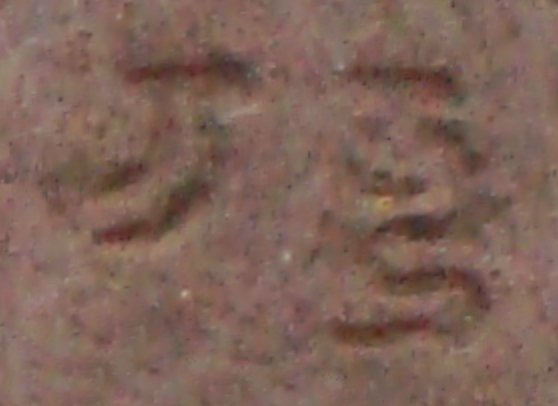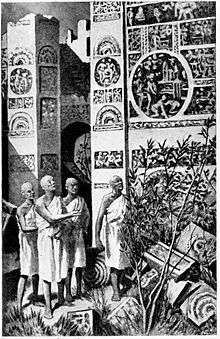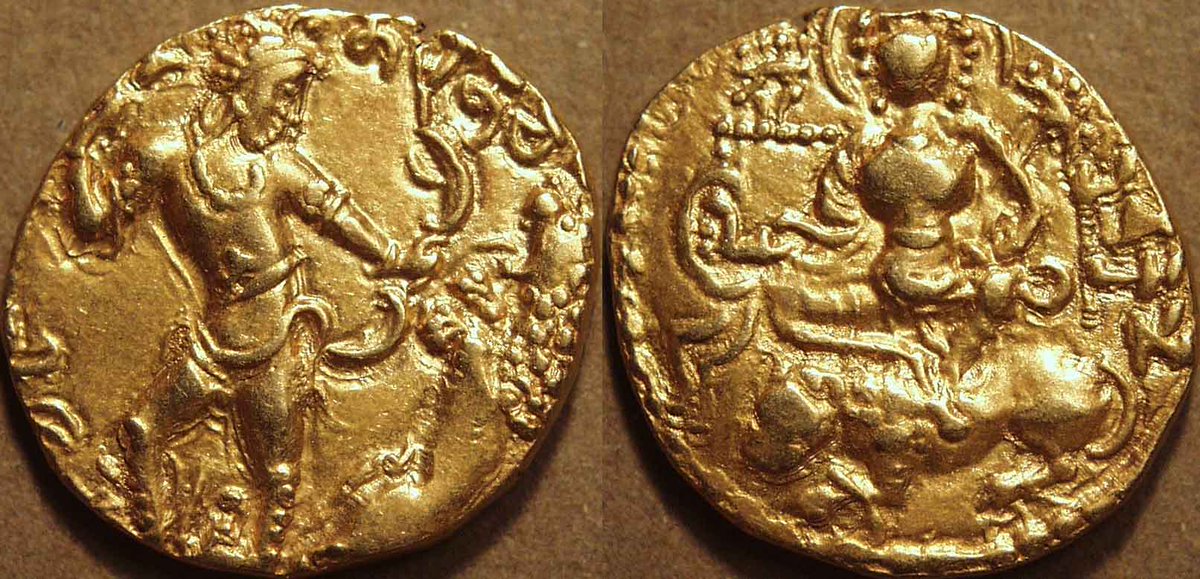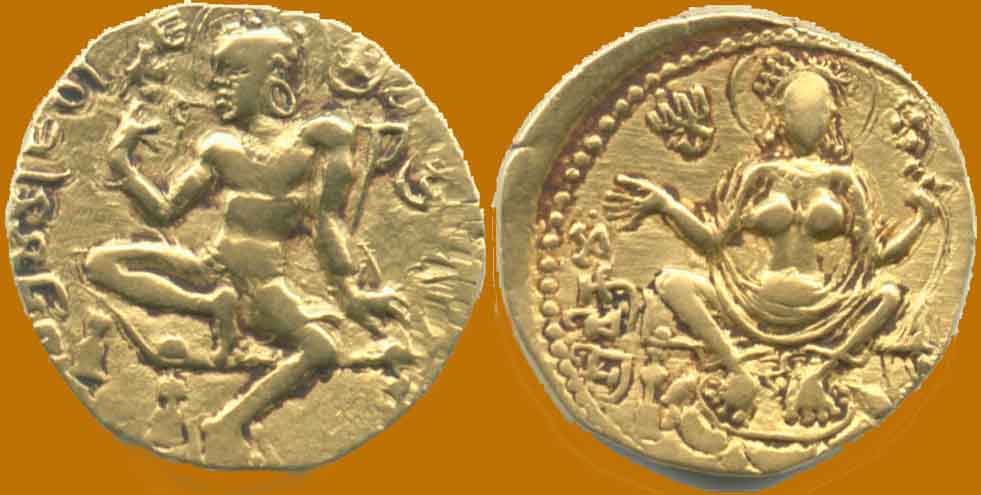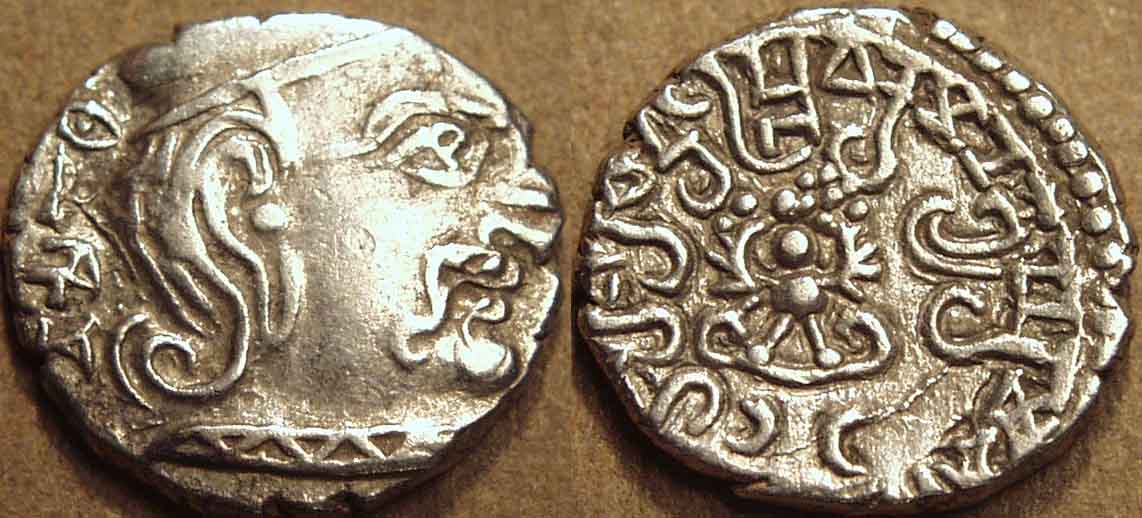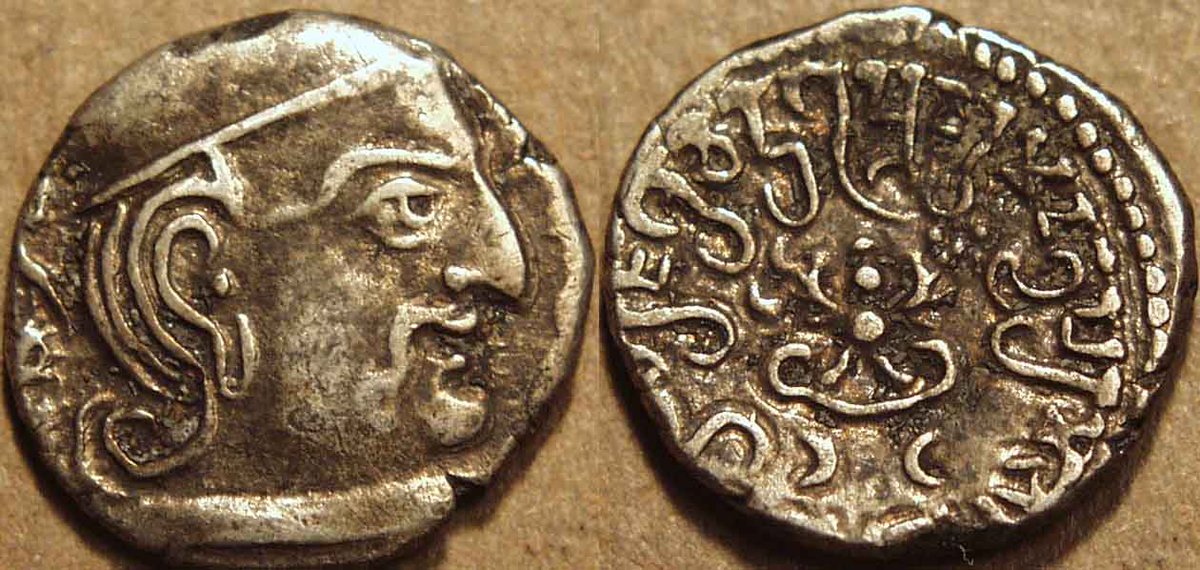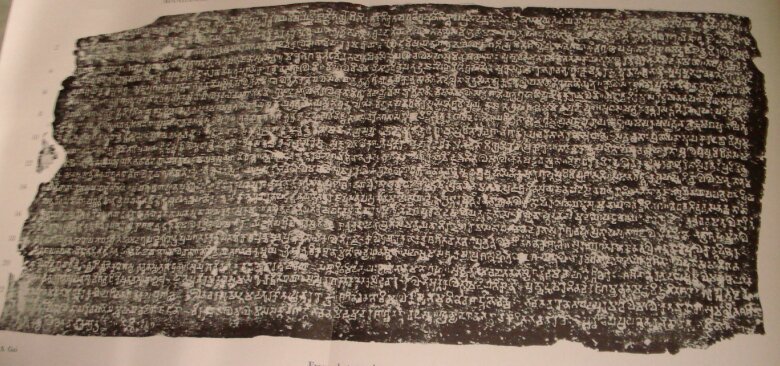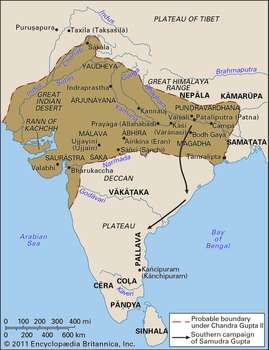Empires of India - Part 3
This part will continue the focus on historical empires of India till 7th Century AD.
Image of a painting at Ajanta Caves of Padmapani Bodhisattva.
This part will continue the focus on historical empires of India till 7th Century AD.
Image of a painting at Ajanta Caves of Padmapani Bodhisattva.
11. Gupta Empire ( 319-550 AD)
The Gupta Empire is the fourth largest empire of India in terms of area conquered ( 3.5 million sq km).
This age is popularly known as the & #39;Golden Age of India& #39;.
The Gupta Empire is the fourth largest empire of India in terms of area conquered ( 3.5 million sq km).
This age is popularly known as the & #39;Golden Age of India& #39;.
The Origins of Guptas are shrouded in mystery.
I-Tsing, who visited India in 690 AD, writes about a king whom he names as & #39;che-li-ki-to& #39;, who has been been identified as Maharaja Sri Gupta
According to I-tsing, the king built a monestary for pilgrims, 500 years before his time.
I-Tsing, who visited India in 690 AD, writes about a king whom he names as & #39;che-li-ki-to& #39;, who has been been identified as Maharaja Sri Gupta
According to I-tsing, the king built a monestary for pilgrims, 500 years before his time.
The Poona Copper Plate inscription of Prabhavati Gupta ( circa 400 AD) mentions the genealogy of Gupta kings.
Sri Gupta, Ghatotkacha Gupta, Samudra Gupta and Chandra Gupta Vikramaditya.
Dharini/Dharana is the gotra of Gupta/emperors according to this inscription ( image).
Sri Gupta, Ghatotkacha Gupta, Samudra Gupta and Chandra Gupta Vikramaditya.
Dharini/Dharana is the gotra of Gupta/emperors according to this inscription ( image).
But, the titles of Sri Gupta and Ghatotkacha Gupta are mentioned as & #39;Maharaja& #39;, whereas the titles for Chandra Gupta - I and his successors are mentioned as & #39;Maharajadhiraja& #39; ( King of Kings).
Accordingly, the historians are of the view that Sri Gupta & Ghatotkacha Gupta ruled a very small portion of Magadha.
The time line of Sri Gupta is between 240-280 AD, and that of Ghatotkacha Gupta is given between 280-319 AD.
The time line of Sri Gupta is between 240-280 AD, and that of Ghatotkacha Gupta is given between 280-319 AD.
Chandra Gupta - I ( 319-335 AD)
The first king of Gupta dynasty to use the title of & #39;Maharajadhiraja& #39; was Chandra Gupta - I.
He started the Gupta era calendar in 319 AD, signifying his ascension to the throne.
& #39;Maharajadhiraja & #39;Sri Chandragupta& #39; as written in Praygraj Pillar.
The first king of Gupta dynasty to use the title of & #39;Maharajadhiraja& #39; was Chandra Gupta - I.
He started the Gupta era calendar in 319 AD, signifying his ascension to the throne.
& #39;Maharajadhiraja & #39;Sri Chandragupta& #39; as written in Praygraj Pillar.
Some historians are of the view that Chandra Gupta- I started the Gupta era calendar on 26 Feb 319 AD, and hence that year may be taken as the date of creation of the Gupta Empire.
Al-Beruni was the first historian to state the date of 319 AD as the start of Gupta reign.
Al-Beruni was the first historian to state the date of 319 AD as the start of Gupta reign.
Since their are no inscriptions of Chandra Gupta-I, historians have placed his suzerainty between Ayodhya and Pataliputra.
Puranas also mention this fact. Others have theorized that Chandra Gupta-I& #39;s empire consisted of the regions from Prayaga to Pataliputra.
Puranas also mention this fact. Others have theorized that Chandra Gupta-I& #39;s empire consisted of the regions from Prayaga to Pataliputra.
Chandra Gupta-I married the Lichchchhavi princess Kumaradevi.
This marriage helped Guptas to gain prestige and political power and it may have helped Chandra Gupta to assume the title of & #39;Maharajadhiraja& #39;.
This marriage helped Guptas to gain prestige and political power and it may have helped Chandra Gupta to assume the title of & #39;Maharajadhiraja& #39;.
There are no coins of Chandra Gupta-I.
However, his son and successor, Samudra Gupta has minted a coin portraying the marriage of Chandra Gupta with Lichchhavi Princess, Kumaradevi.
However, his son and successor, Samudra Gupta has minted a coin portraying the marriage of Chandra Gupta with Lichchhavi Princess, Kumaradevi.
The coin portray the marriage, showing the husband offering with his right hand, a ring to his wife.
They also bear the legend & #39; Chandra& #39; vertically just beneath the left arm of the king.
On obv, we have the name of & #39;Kumaradevi& #39;, along with the legend & #39;Lichchhavidohitrah& #39;.
They also bear the legend & #39; Chandra& #39; vertically just beneath the left arm of the king.
On obv, we have the name of & #39;Kumaradevi& #39;, along with the legend & #39;Lichchhavidohitrah& #39;.
The words & #39; Lichchhavidohitrah& #39; assumes importance as Samudra Gupta, here is implying himself as the maternal relative to the Lichchhavis.
This suggests the importance Guptas gave to this relation with the Lichchhavis.
Chandra Gupta - I was succeeded by Samudra Gupta in 335 AD.
This suggests the importance Guptas gave to this relation with the Lichchhavis.
Chandra Gupta - I was succeeded by Samudra Gupta in 335 AD.
Samudra Gupta ( 335-375/380 AD)
He has been called & #39;Sarvarajyavicchyotah& #39; or the Exterminator of the Kings.
This title has only been given to Samudra Gupta of all Gupta Emperors and we will see why !
Image of a lyricist type coin of Samudra Gupta.
He has been called & #39;Sarvarajyavicchyotah& #39; or the Exterminator of the Kings.
This title has only been given to Samudra Gupta of all Gupta Emperors and we will see why !
Image of a lyricist type coin of Samudra Gupta.
The Praygraj Pillar inscription (formerly Allahabad Pillar), details the conquests of Samudra Gupta.
The inscription is written by Harisena, who was the court-poet of Samudra Gupta, and is undated. But probably, it was inscribed after Samudra Gupta& #39;s conquests.
The inscription is written by Harisena, who was the court-poet of Samudra Gupta, and is undated. But probably, it was inscribed after Samudra Gupta& #39;s conquests.
This pillar has also an inscription of Ashoka, particularly his & #39;Queen edicts& #39;, where he mentions the name of his Queen Kaurwaki & son named Tivara.
It is interesting that the content of Ashoka& #39;s and Samudra Gupta& #39;s inscriptions are poles apart.
It is interesting that the content of Ashoka& #39;s and Samudra Gupta& #39;s inscriptions are poles apart.
While Ashoka was a pacifist, and details his & #39;dharma& #39; on his inscriptions, Samudra Gupta& #39;s inscriptions talks about war, battles and conquest.
Image of Samudra Gupta& #39;s inscription on Praygraj Pillar.
Image of Samudra Gupta& #39;s inscription on Praygraj Pillar.
In his first campaigns of north India, Samudra Gupta vanquished kings named as Nagasena, Achyuta, a king of Kota dynasty and another king of Nagas.
Wishing to extend his suzerainty in the South, Samudra Gupta next crossed the Vindhyas and defeated 12 kings of south India.
He went as far as Kanchi and Pallakad, however here he stopped.
Image of Samudra Gupta& #39;s campaigns in the South.
He went as far as Kanchi and Pallakad, however here he stopped.
Image of Samudra Gupta& #39;s campaigns in the South.
His conquests in the South was marked by three features:-
1) & #39; Grahana& #39; ( Capture of the Enemy),
2) & #39; Moksha& #39; ( Liberating him), &
3) & #39; Anugraha& #39; ( favouring him by reinstating him in his kingdom)
1) & #39; Grahana& #39; ( Capture of the Enemy),
2) & #39; Moksha& #39; ( Liberating him), &
3) & #39; Anugraha& #39; ( favouring him by reinstating him in his kingdom)
This policy may be taken to be the only policy of a conqueror could pursue in the distant South , where Samudra Gupta was only anxious that his position as the paramount sovereign of India should be recognized.
Coming back to north again, he found himself in a ring of hostile states, who could be a danger to his suzerainty, he therefore started a second war of extermination and most notably, vanquished Rudradaman - I, King of Vakatakas ( 344-348 AD).
Samudra Gupta was an accomplished fighter, & #39;like a tiger& #39; or & #39;Vyaghraparakrama& #39;, as he is called in his coins.
He fought in the front ranks, and had hundred of marks of spear, sword, arrows,on his body & #39;which shone like jewels& #39; as Harisena puts it.
He fought in the front ranks, and had hundred of marks of spear, sword, arrows,on his body & #39;which shone like jewels& #39; as Harisena puts it.
He is known as & #39;Napoleon of India& #39;, but unlike Napoleon Samudra Gupta never met his waterloo !
Apart from a fighter, he was also a great administrator, poet and a musician as well.
He has been called & #39;Kaviraja& #39; by Harisena, however his poems are lost us.
Image of Samudra Gupta
Apart from a fighter, he was also a great administrator, poet and a musician as well.
He has been called & #39;Kaviraja& #39; by Harisena, however his poems are lost us.
Image of Samudra Gupta
Samudra Gupta issued gold coins which are named by historians as:
1) Kacha Type
2) Battle-Axe Type;
3) Ashvamedha type
4) Lyrist type
5) Tiger-Slayer type.
1) Kacha Type
2) Battle-Axe Type;
3) Ashvamedha type
4) Lyrist type
5) Tiger-Slayer type.
The Eran stone inscription of Samudra Gupta ( image) states that he bought & #39; whole tribes of kings& #39; under his suzerainty & that his enemies were terrified when they thought of him in their dreams.
Samudra Gupta was succeeded by his son, Chandra Gupta - II in year 375 or 380 AD.
Samudra Gupta was succeeded by his son, Chandra Gupta - II in year 375 or 380 AD.
Chandra Gupta - II ( 375/380 - 414 AD)
He was the son of Samudra Gupta & Dattadevi.
The Mathura Pillar inscription of Gupta year 61 (380 AD) is the first inscription mentioning the ascension of Chandra Gupta as a king.
Image of Mathura Pillar inscription of Gupta year 61.
He was the son of Samudra Gupta & Dattadevi.
The Mathura Pillar inscription of Gupta year 61 (380 AD) is the first inscription mentioning the ascension of Chandra Gupta as a king.
Image of Mathura Pillar inscription of Gupta year 61.
Also popularly known as Chandra Gupta Vikramaditya, he is credited with the final destruction of Western Satraps or Sakas , and annexing the whole of Gujarat and Sindh into Gupta Empire.
An Artist impression of Chandra Gupta Vikramaditya going to war against the Sakas.
An Artist impression of Chandra Gupta Vikramaditya going to war against the Sakas.
He married his daughter, Prabhavati Gupta to Vakataka King Rudrasena II, and after her husband& #39;s death, she ruled as a regent to her minor sons till 405 AD.
In effect Vakatakas came under the suzerainty of the Gupta Empire.
In effect Vakatakas came under the suzerainty of the Gupta Empire.
The Delhi Iron Pillar talks about his & #39; battles across the seven rivers& #39; ( rivers of Punjab) and taking his arms up to Balkh, in Afghanistan.
He is credited with the final annexation of Bengal to Gupta Empire.
Image of word & #39;Chandra& #39; on Delhi Iron Pillar, along with the pillar
He is credited with the final annexation of Bengal to Gupta Empire.
Image of word & #39;Chandra& #39; on Delhi Iron Pillar, along with the pillar
Chandra Gupta Vikramaditya had & #39; 9 jewels& #39; or Navratnas in his court. They include:
1) Kalidasa;
2) Amarasimha ;
3) Dhanvantari ;
4) Ghatakarapara ;
6) Kshapanaka ;
6) Shanku ;
7) Varahamihira ;
8) Vararuchi ; and
9) Vetala Bhatta
1) Kalidasa;
2) Amarasimha ;
3) Dhanvantari ;
4) Ghatakarapara ;
6) Kshapanaka ;
6) Shanku ;
7) Varahamihira ;
8) Vararuchi ; and
9) Vetala Bhatta
The great Chinese scholar Fa-Hien visited India during the years 399-414 AD, and has left a memorable account of the country and its social conditions as he found under the reign of Chandra Gupta Vikramaditya.
Image of Fa-Hien at Pataliputra
Image of Fa-Hien at Pataliputra
Fa-Hien says: & #39; The King in his administration uses no corporal punishment; criminals are merely fined according to the gravity of their offences.& #39;& #39;
& #39;Attempts to rebel are forgiven for the first time. Second time, the right hand is cut off.& #39;
& #39;Attempts to rebel are forgiven for the first time. Second time, the right hand is cut off.& #39;
& #39; Throughout the whole country no one kills any living things, nor drinks wine , nor eats onions or garlic ; but Chandalas are segregated.
& #39;Chandal& #39; is their name for foul men ( lepers).& #39;
& #39;Chandal& #39; is their name for foul men ( lepers).& #39;
& #39; In this country, they do not keep pigs or fowls, there are no dealings in cattle, no butcher& #39;s shops or distilleries in their market places.& #39;
& #39; The people further, seek salvation by building alongside out-of-the-way roads, homes of charity, where food , drinks and clothes are offered to travellers, without any cost.& #39;
& #39; People compete with one another for doing charity work.& #39;
& #39; People compete with one another for doing charity work.& #39;
This is a remarkable testimony to public philanthropy inspired by the spirit of social service, the religion ( Hinduism) which inculcated worship of God as embodied in humanity & #39; Nara Narayana& #39; & expressed itself in helping others without distinctions of caste, creed or religion.
The first hand account proves that the material and moral progress of the country was highest during the reign of Chandra Gupta Vikramaditya.
Perhaps, India was and will never be governed this well again !
Perhaps, India was and will never be governed this well again !
Chandra Gupta Vikramaditya minted several types of gold coins. The gold content in these coins is far greater than any previous era coins, indicating the prosperity of India.
1) Lion Slayer type ;
2) Couch type ;
3) Chattra Type ;
4) Horseman type ;
5) Archer type
1) Lion Slayer type ;
2) Couch type ;
3) Chattra Type ;
4) Horseman type ;
5) Archer type
He also introduced silver coins in his reign.
These coins were found in Gujarat & is testimony to the Gupta annexation of that area
The coins are modelled after the Sakas rulers of this area, with kings face on obv and garuda symbol on reverse, with the legend & #39;Parambhagvatah& #39;.
These coins were found in Gujarat & is testimony to the Gupta annexation of that area
The coins are modelled after the Sakas rulers of this area, with kings face on obv and garuda symbol on reverse, with the legend & #39;Parambhagvatah& #39;.
Other names of Chandra Gupta, as taken from his inscriptions and coins are:
1) Chandra
2) Simhavikramah
3) Sakari
4) Ajitvikramah
5) Vikramanka
6) Vikramaditya
1) Chandra
2) Simhavikramah
3) Sakari
4) Ajitvikramah
5) Vikramanka
6) Vikramaditya
Chandra Gupta Vikramaditya had many wives. We know the names of two of his wives, Kubernaga, the princess of Naga dynasty and mother of Prabhavati Gupta
Mahadevi Dhurvaswamini or Dhruvadevi was his chief Queen and mother of Kumara Gupta - I
He was succeeded by Kumara Gupta- I
Mahadevi Dhurvaswamini or Dhruvadevi was his chief Queen and mother of Kumara Gupta - I
He was succeeded by Kumara Gupta- I
Kumara Gupta - I ( 414/415 - 455 AD)
Chandra Gupta Vikramaditya was succeeded by his son, Kumara Gupta - I. His mother was Mahadevi Dhruvaswamini.
His earliest date is Gupta year 96 =415 AD, as inscribed in the Bilsad inscription
Image of Bilsad inscription
Chandra Gupta Vikramaditya was succeeded by his son, Kumara Gupta - I. His mother was Mahadevi Dhruvaswamini.
His earliest date is Gupta year 96 =415 AD, as inscribed in the Bilsad inscription
Image of Bilsad inscription
The Mandsaur inscription of Gupta year 117=436 AD, refers to Kumara Gupta & #39;reginging over the whole earth& #39; ( kumaragupte prithvim prasasti)
Image of Mandsaur Inscription
Image of Mandsaur Inscription
According to the above inscription, Mount Kailasa and Sumeru were the northern edges of the empire, Vindhyas the southern boundaries & surrounded by seas from three sides.
Thus, Kumara Gupta - I was at the zenith of his power & the Gupta Empire had its greatest extent in 436 AD.
Thus, Kumara Gupta - I was at the zenith of his power & the Gupta Empire had its greatest extent in 436 AD.
There are at least 21 inscriptions of Kumara Gupta, namely Gangadhar inscription, Mankunwar inscription, Karmadanda stone inscription, etc.
All of these inscriptions point out to the fact that India was politically stable and a very prosperous country.
All of these inscriptions point out to the fact that India was politically stable and a very prosperous country.

 Read on Twitter
Read on Twitter